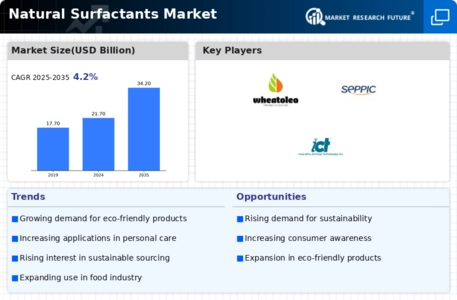Market Trends
Key Emerging Trends in the Natural Surfactants Market
The natural surfactants market has been all over the place lately, with so many consumers revolving their focus around clean and green products. Surfactants, which are the surface-active agents, feature prominently across different industries such as personal care, household cleaning, and agriculture among others. The demand for natural surfactants has seen a significant rise amidst the quest for alternatives to traditional synthetic surfactants, which could possibly pose environmental and health troubles.
Sustainability is among the basic issues that the natural surfactants market is dealing with now. Consumers these days are more aware about the environmental footprints of products and hence preference is given to the ones that use renewable resources and have minimum impact on the ecosystem. Eco-friendly surfactants, usually from plants or other natural materials such as these, have become the choice of the conscious consumers. The manufacturers are endeavoring to do so by integrating these sustainable surfactants in a wide variety of products, including soaps, shampoos, and detergents, among others.
The personal care segment has been a true game changer. The shift in lifestyle of people is reflected in the demand for natural and organic products. Natural surfactants are especially well known in cosmetology and personal care thanks to their mild and skin-friendly properties. In light of the fact that the negative side of synthtic surfactants is becoming more recognized, consumers tend to prefer products that are not only effective but also free from harmful chemicals. This has, in turn, given rise to an increase in the use of natural surfactants by cosmetic and personal care product manufacturers who are also pushed to produce green (cleaner) alternatives.
The other notable trend is the widening of the natural surfactant applications Meanwhile, personal care and household cleaning are ones that still consume the bigger part of the market while, agricultural industry has witnessed a fast uptake of natural surfactants. The surfactants in agricultural formulations are the backbone of even distribution of pesticide and herbicide. With the increasing industrialization of the agricultural sector, there is an increasing focus on sustainable production processes and environmentally friendly practices. In this context, the demand for surfactants of natural origin is likely to keep rising.
Market players are increasingly focusing on research and development activities in order to extend the variety of the natural surfactant product line. By means of creative approaches in extraction, development of novel sources of natural surfactants, the industry is able to satisfy the increasing need of multiple sectors. Moreover, the partnership and collaboration among the major industrial players and the researchers from research institutes are responsible for the growth and development of the natural surfactants market.


 Source: Secondary Research, Primary Research, Market Research Future Database and Analyst Review
Source: Secondary Research, Primary Research, Market Research Future Database and Analyst Review



Leave a Comment